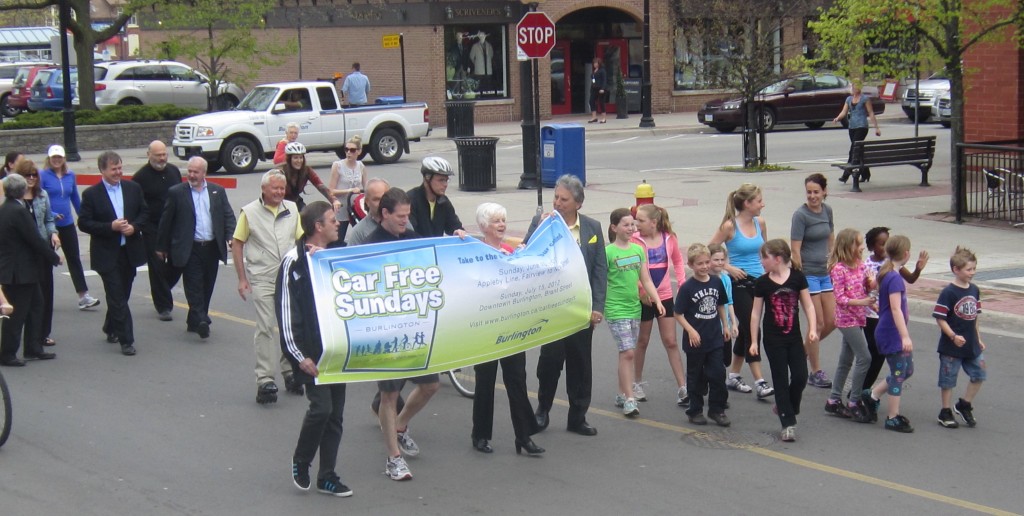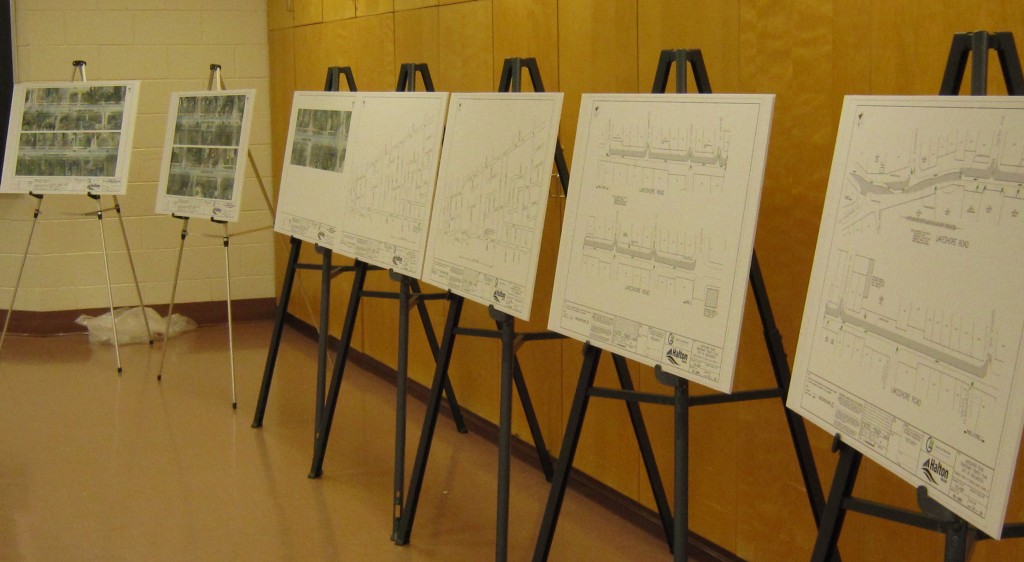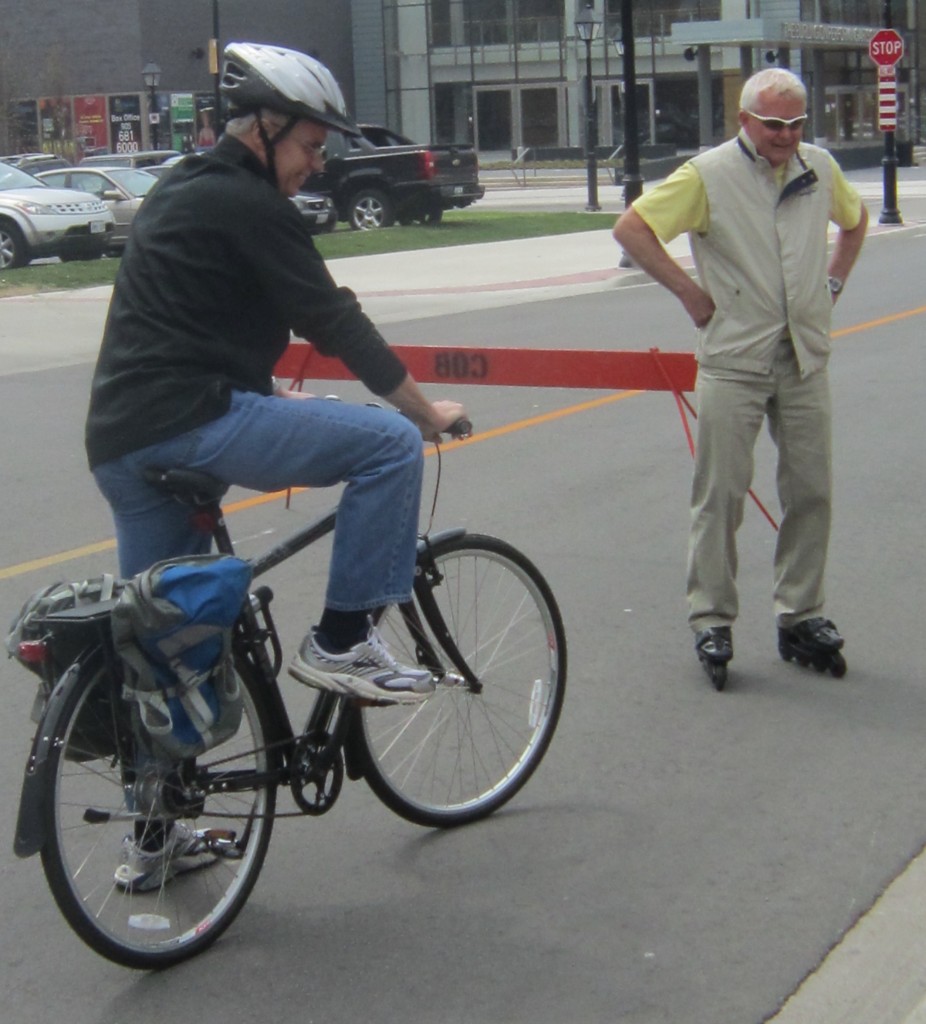BURLINGTON, ON. January 28, 2012 A city council committee took four hours two weeks to get to the point where they voted 4-2 to go ahead with a pilot project to collect data on just what having bicycle lanes on either side of Lakeshore Road from Seneca Avenue eastward to Guelph Line would do to the flow of traffic. That vote now has to be confirmed at a city council meeting tonight. It is expected to fail.

The public seemed to want Car Free Sundays so that bikes could take over the streets – but that same public doesn’t want the bikes in their own lanes on Lakeshore Road.
Ward 4 Councillor Jack Dennison attended a public information meeting a few days later on the water main work that has to be done along Lakeshore Road before the lane markings get put in and said he expects to be tarred and feathered by the people he represents for supporting the pilot plan. He added that the Mayor is feeling the pressure. When asked if he thought the Mayor would hold, Dennison gave that look that suggested he too wondered if the Mayor would cave in to the pressure.
And there is pressure. The Mayor is being bombarded with emails and phone calls.
What the city doesn’t have is very much in the way of real, supportable data. What it does have is a lot of emotion.
I drove the stretch of road that is at issue – Lakeshore Road from Seneca Avenue to Guelph Line – and yes there was traffic but I had no problem making left hand turns into Seneca from Lakeshore nor did I have any problem making a left hand turn back onto Lakeshore from Delaware where I continued along Lakeshore and made a left north onto Green. I then drove along First went south on Beaver and made another left onto Lakeshore.
There was always oncoming traffic – but other than waiting – say maybe 10-15 seconds – I had no problem and there was never a back-up of traffic behind me when I was proceeding east on Lakeshore.
“When did you do this trial run”, I was asked. On Monday between 5:05 pm and 5:25 pm. “You went too early I was told”.
There are a lot of emotions about this issue but policy doesn’t get made based on emotions – does it?
The objective of the pilot is to determine if the changing of the size of the various traffic lanes on Lakeshore Road will affect people who live in the area adversely.
Three of the six council members are directly impacted by any changes to this road: Sharman, Meed Ward and Dennison. Meed Ward, whose Newsletter is the best of any council member, sets out why she voted against the change in lane markings. Her comments follow:

Councillor Meed Ward has always been good at listening – is the LAkeshore Road cycling issue an opportunity to lead?
My Take: Along with my colleagues councillors Sharman and Taylor, I support retaining the current configuration of Lakeshore Road, primarily for safety reasons for all road users. Here are 10 reasons why we need to retain the centre lane on Lakeshore Road, and take steps that will actually deliver on the goal of helping residents to use cycling and active transportation.
1. The road is currently functioning safely.
Transportation staff have confirmed that the collision type and number are what you’d expect for an arterial road, and it is not listed on the Top 10 of problem roads in Burlington. In short, the road is safe for both drivers and cyclists.
2. Current cycling infrastructure in this area is adequate.
The Centennial bike path provides a safe, segregated and beautiful route for cyclists heading between downtown and the east of the city. In addition, there is the multi-use asphalt path on the South side of Lakeshore Rd. That path will be upgraded as part of the road reconstruction. A number of cyclists told council that for speed reasons they don’t like to use either Centennial path or the multi-use path, but the bottom line is that these services exist. No one is required to cycle on the road. Riders who feel safe on Lakeshore Road already cycle there without a bike path; those who don’t likely won’t cycle on Lakeshore Road even with a bike lane.
As an aside, the city is poised to invest heavily in cycling infrastructure – the proposed capital budget for 2013 includes $1.25m for new and upgraded multi-use paths throughout the city – we need to encourage cyclists to use these paths, rather than compromise road safety for everyone.
3. Changes to the road will compromise safety for both cyclists and drivers.
Residents on Lakeshore Road remember when the centre turn lane was installed for the safety of cars turning left onto and off of the road. They noticed fewer collisions after the centre turn lane was installed. I have asked Transportation Staff to provide that data (it should have been part of the initial report). Further, with just a narrow painted median for cars to wait while turning left, passing vehicles will veer into the cycling lane to pass, putting cyclists at risk.
4. Delays will result.
Traffic flow will be impeded by removing the centre turn lane, stealing precious minutes of time from families due to commuting, reducing their quality of life and adding further emissions to the air, affecting both drivers and cyclists. As one resident said in a letter to committee: “Should we not be concerned about the plan’s generation of so much idling traffic, with its resulting air pollution, in such close proximity to a public school and a dense residential area…There’s a Burlington by-law to stop vehicles idling for over 30 seconds; how many violations of that by-law will be directly caused by this plan?”
5. If you build it they will come only works in the movies.
We’re told that on-road bike lanes will increase the number of people cycling, but this vague hope fundamentally misunderstands why people don’t cycle now. It’s not because there is a lack of on-road bike lanes; it’s because more than half our residents must leave the city to work. Until we focus on economic development and bringing jobs to Burlington, cycling to work will remain a dream for our residents, even with on-road bike lanes. As one resident said in her letter to committee: “I like cycling myself. I cannot, however, find a way to bike my two children to daycare and then down to St. Catharines in order to do the job that pays my property taxes in Burlington….I have found biking over 100km a day to be especially trying in winter.”
6. There is no data to suggest on-road bike lanes will increase cycling in Burlington or has done so where bike lanes have been added.
Creating congestion and traffic delays as a means to get people out of their cars and onto bikes, without taking steps to rectify why people don’t cycle now, only produces…..congestion and delays. We need to balance the needs of all road users; this proposal creates significant safety and other negative impacts for the vast majority of current road users. It’s not balanced. Cyclists and cars are sharing the road well now.
7. Families won’t cycle on Lakeshore Road.
For many families and individuals on-road cycling is too dangerous even with on-road bike lanes. Our residents are looking for dedicated bike paths and separated bike lanes – Ottawa is a good example. This will take more planning and time – a precious commodity in an impatient world of instant gratification – but separated bike paths will go further to achieving the results we want.
8. The “pilot” has no goals to determine success (or failure).
The pilot will measure vehicle counts, travel time, bicycle counts and motor vehicle collisions, but no thought has been given to how many more cyclists will be required to deem the pilot a success, or how many accidents or delays are “acceptable” to deem this a success. Even one accident is too many – we should not be using our residents as guinea pigs to test the safety of the road. The lack of clear targets creates the impression that calling this a pilot is simply a device to push this through without proper data, consideration or due process.
9. Poor process leads to poor decisions.
This project has suffered from lack of good data and poor public consultation – being sprung on residents before Christmas, with a proposed amendment coming days before the final vote. There was no opportunity for a public meeting that would have provided an opportunity for table group discussion to learn from our residents what would help them pursue a more active lifestyle, and whether on-road cycling lanes on Lakeshore Road will have any impact at all on their cycling patterns.
10. We ignore the public at our peril.
More than 125 residents wrote to me and other members of council, to ask that the centre turn lane be retained. An additional 250 residents submitted a petition asking for the road to remain as is. Residents have clearly communicated their concerns, and goals for a balanced approach to cycling infrastructure. Yet those have been set aside. We’ve been told that supporting the on-road bike lanes at any cost to drivers and despite the concerns of residents, is showing “leadership.” Leadership has become the code word to justify ignoring public input.
The best decisions are made by carefully consulting and considering the views of the people most directly affected by our decisions. The city’s commitment to community engagement is built on this premise. It recognizes that elected officials don’t have a corner on wisdom (no one does), but that collectively there is much wisdom in our community if we listen and learn from each other.
When politicians dream about the future and impose a solution, it doesn’t always work out the way it’s supposed to, and residents are left suffering with the consequences until we fix it. One example will suffice: last week, council members discussed parking problems in the Uptown community of Burlington in Ward 5. This community was designed as high density with limited parking to “get people out of their cars” and onto transit. It didn’t work – people still have to drive outside the community for work, or long distances for shopping or recreation. So now Councillors are having to fix the situation, and have approved relaxed on-street parking rules in the area. Several councilors expressed surprise that the vision hadn’t worked. The reason: without jobs (and shopping and recreation) close by, residents still have to drive.
Making it hard for residents to drive doesn’t automatically get them out of their cars, if nothing else in the community changes. We need to heed this lesson before imposing hardship on the users of Lakeshore Road.
Meed Ward is not going to ignore her public – but she isn’t going to lead it either.

The proposed pilot test of new lane markings on Lakeshore Road would run from Seneca (not Torrance) east to Guelph and have a very small divider lane with exclusive bike lanes on either side. Residents see that small divider lane as too small for them to make left hand turns.
Dennison who is an avid cyclist, thinks the cycling lanes are part of the direction Lakeshore Road should be going in.
Sharman, who is also a consistent bicycle user and a strong proponent of the Car Free Sundays appear to be reacting to public pressure. For a guy who always wants the data he doesn’t seem too concerned about the lack of data on this issue.
The whole idea was to determine if putting bicycle lanes on either side of Lakeshore road would make any difference to the flow of traffic.

The Region ensured that the public got an opportunity to fully understand what was going to happen to Lakeshore Road when the water main was upgraded. The public was given useful data. Why can’t the public let the city gather useful data on what separate bike lanes would do to the flow of traffic on Lakeshore? Perhaps because emotions are over ruling reason?
The road is going to get ripped up to have a new water main put in by the Region and no one is grousing about the problems that is going to cause. When the road is resurfaced after the water main has been installed the city wants to remark a section of the road and make provision for bike lanes that will stay in place from about September of this year until April of 2014.
What’s the big deal? If it becomes evident that the road cannot safely, and at little inconvenience to the people who live in the immediate area, handle the change in lane markings, then bike lanes should come out.
After driving about Lakeshore I headed north up Appleby Line to look at a parking problem in the Uptown area and then headed west along Upper Middle Road. If you want to have to handle traffic and struggle to make a left hand turn, with traffic lights to help – try Upper Middle. I wanted to go south on Walkers to get home. The traffic was backed up and it was going to take several lights before I would make it through the intersection.
I went further west to Centennial and was able to make a left and get home.
Upper Middle Road was a lot harder to drive than Lakeshore Road. And there were bike lanes which didn’t get in the way – but then it was cold, cold, cold and there was just the one brave cyclist on the road.
We have added some material from a city, Minneapolis, that has an active cycling policy in place. They have snow there and they have the coldest average temperature of any major metropolitan area in the United States.
The City of Minneapolis Bicycle Program is integrated into many divisions and departments at the city. The core staff of the Bicycle Program operates out of the Traffic & Parking Services Division of the Public Works Department. They have the primary responsibilities of educating the public through the Bike Walk Ambassador Program and implementing new projects through the Non-Motorized Transportation Pilot Program. Bicycle Program staff also produces the Minneapolis Bicycle Map and organizes the annual bicycle count. Other staff in Traffic & Parking Services responds to bicycle traffic safety issues and rents out bike lockers at municipal parking ramps in the downtown area.
Elsewhere in Public Works, new off-street bike trail projects, the bike rack cost share program, and the Bicycle Master Plan are managed by staff in the Transportation Planning & Engineering Division. Many Minneapolis bikeways are cared for by crews in the Street Maintenance & Repair Division.
In the Minneapolis Police Department, the Bicycle Recovery Unit stores recovered and abandoned bicycles and holds bicycle auctions. The Traffic Unit investigates accidents between bicyclists and motorists. The Traffic Control Unit enforces parking rules in bike lanes. Police officers in each of the five precincts enforce bicycle-related laws and respond to emergencies. Twenty-Eight percent of the MPD police force is certified to patrol by bicycle.
This is a city with a committed policy and pro-active programs that lead to, foster and support increased use of cycling.
Burlington has a Master Cycling Plan and does make attempts to promote cycling. The city held a Bike to Work day event at which breakfast was served for those who arrived at city hall on their bikes. The Mayor was there on the bike that seems reserved for just photo ops; he does not ride to work on a bicycle.
Cyclists have a right to be on every road in the city – not the 400 series roads but certainly on Lakeshore Road. They have a right to the safe use of those roads. Bike lanes will be safer. Will creating exclusive bike lanes make it safer for cyclists and not unduly delay car drivers – that’s what the six to nine month trial was being put in place to tell us.

Will this Mayor on his bike ever get to ride on a separate and safe bike lane on the Lakeshore Road? Not if they Mayor folds at city council this evening.
The cycle enthusiasts put forward some very solid data at the council committee meeting that deserves attention. Those opposed to the cycle lanes gave anecdotal evidence that had an obstetrician missing a birth because of traffic. Why didn’t he leave earlier; he certainly knew the road and its traffic patterns.
Councillor Sharman fanned useless flames when he spoke of the possibility of one of his constituents dying in an ambulance because it got tied up in traffic – such rubbish.
Mayor Goldring speaks glowingly of the cycle plans he saw in Portland, Oregon when he visited that city. The glow appears to have rubbed off – most indications are that the mayor is getting antsy about the vote for the pilot he cast at a council committee meeting.
Looks like we are in for a long city council meeting tonight.



















Who’re the “two dudes” rationalizing a very poor plan?
Once the Lakeshore re-paving is finished, they intend to install painted ‘sharrows,’ at a cost of $40 thousand … by unanimous consent, which was decided at the final meeting where the proposition failed to pass. Have you ever heard of Pavlov and his doggies … encouraging behaviour, with a food reward system? The difference here, is that there is no reward.
A relatively quick search yields high mortality rates among cyclists because they are thrown into a hazardous environment. There is also ample evidence of pedestrians being killed by cyclists on sidewalks, who, for obvious reasons don’t trust car drivers. I don’t trust car drivers either, when I’m driving a car. A lot of them ONLY OFFER one-half of the peace symbol, and sometimes not even that, when they’re cutting you off!
Some anecdotal, which may or may not convince readers.
https://www.thetimes.co.uk/tto/public/cyclesafety/article3313260.ece
https://www.thetimes.co.uk/tto/public/cyclesafety/article3650057.ece
https://www.thestar.com/news/gta/2011/09/01/cyclists_defend_using_sidewalk_where_pedestrian_was_struck_and_killed.html
https://www.insidehalton.com/news/article/1545092–lakeshore-rd-bike-lane-pilot-project-proposed
It appears we’re going to have to make some councillor changes at time of the 2014 municipal election. My advice is to save the $40 thousand by totally dropping the Pavlov doggie concept.
Cyclists travelling through the North York neighbourhood where Nobu Okamoto, 74, was run down by a bicycle are defending their choice to use the sidewalk, just days after he died from his injuries.
On Thursday afternoon, a Star reporter witnessed at least 10 cyclists on Finch Ave. W., near Sentinel Rd., fail to comply with the bylaw that prohibits riding on sidewalks on vehicles with wheels larger than 61 centimetres in diameter.
Okamoto’s family insists that bikes have no place on the sidewalk, but local cyclists say they have no choice due to narrow roads and fast cars.
One thing that wasn’t mentioned is that under the present configuration on Lakeshore, it is illegal to use the centre turn lane as a passing lane. Therefore legally motor vehicles should remain behind a cyclist until a passing lane is reached no matter how slow the cyclist is travelling. If there were bike lanes, motorists could drive unhindered. Surely bike lanes would improve safety and impede traffic less. It should also be noted that the centre turn lanes were installed when Lakeshore was highway No. 2, the QEW was only 4 lanes and there was no bridge over Bronte Creek on Rebecca.
John,
As a long-time resident of South Burlington, I’ve driven along Lakeshore Road when there was only a centre yellow line. Let me assure you, the addition of the centre turning lane was added and it has worked effectively. Lakeshore is too narrow a road to accommodate bike lanes without compromising vehicle safety. And since the overwhelmingly large majority of South Burlington residents are drivers, not cyclists, council made the responsible decision.
The proposition, as offered, presents a major opportunity for traffic constriction, accidents and loss of life among vehicle operators and cyclists. The FACT of attempting to carry forward a BAD PLAN, in terms of a blanket unanimous endorsement in the painting of lines astounds me. I’m not happy with anything that has been put forward by City. They, including the apparent project author, Dennison, are worthy of contempt and subject to the remedies offered Oct-Nov 2014
Meed-Ward has good arguments – until you scratch the surface. Her statement is first, followed by my rebuttal.
1. The road is currently functioning safely: It is not soley about the road functioning safely – it is about encouraging more people to be active. Cycling is a part of that. People will cycle if they feel safe. It is about the environment and health and a host of other issues.
– bike lanes do this encourage more people to cycle – Cycling Master Plan – page 16 for types of cyclists
– plus one rider who spoke the other night mentioned he has had 3 accidents, only 1 was reported to the police – the other 2 weren’t because he was not seriously physically hurt. All 3 accidents occurred where there were no bike lanes.
2. Current cycling infrastructure in this area is adequate: Depends on your perspective. Look at Pythagorean theorem. For a cyclist to go in a straight line it is 4 km, to go across the hypotenuse, it is 5, to drop back down (90 degree angle) it is 3 km
– so, for me to get to Oakville from Burlington, as a cyclist I can take the direct Lakeshore route for 4 km
– or I can use the bike path, which goes north east, for 5 km, then drop down for 3 km, with multiple stops (taking more time and physical effort) at each road intersection
– so instead of riding 4 km quickly, I need to ride 8 km slowly… keep in mind that cyclist can be of many age groups and physical abilities. from my 82 year old mother to 20 year old racers to 16 year olds going to work at their first job.
3. Safety affected by adding bike lanes: After addition of the centre turn lane, there was no change in the number of accidents – from the city’s own report and cited by the Councillor
4. Delays will result.: No facts – but there are facts that state the opposite is true. Installing bike lanes makes traffic better for all road users.
5. If you build it they will come only works in the movies. Blatantly FALSE: There are multiple studies, including this one from from Beuhler & Pucher, 2011 at this link https://jointcc.info/viewtopic.php?f=9&t=183 that say that build it and they will come is TRUE
6. There is no data to suggest on-road bike lanes will increase cycling in Burlington or has done so where bike lanes have been added: There is data from the City, produced on the 28th, that shows that 600 people cycled on Appleby between Lakeshore and New street in one week in January 2013. You need to start gathering data at sometime. There is a 90 North American city study that states that cyclists follow the infrastructure build, regardless of climate, topography, socio-economic background. (see Beuhler & Pucher, 2011)
7. Families won’t cycle on Lakeshore Road: Who knows who will cycle there, but we need to encourage more people to cycle. Who would have thought LA would go from a cess pool for cyclists to planning for 1,680 miles of on-road bike lanes in the next 30 years or that Toronto’s notoriously anti-bike Mayor Ford would have 80 km of on-road bike lanes, 160 km of off-road bike lanes in 2013 budget. See again the types of cyclists on page 16 of the Cycling Master Plan. https://www.latimes.com/features/health/la-he-0126-villaraigosa-biker-20130126,0,4079324.story?page=1
8. The “pilot” has no goals to determine success (or failure): Well, the Cycling Committee put forward some goals, City staff put forward some goals. No goals were put forward by the Councilor. But if you want a goal, how about increasing cycling by 50% over the next 5 years? That is the goal of the country of England, backed with money for infrastructure to see it is accomplished. Cycling infrastructure does not cost, it pays for itself. Entire countries (ie England) have plans for encouraging active transportation. See this link: https://jointcc.info/viewtopic.php?f=9&t=11
9. Poor process leads to poor decisions: The next opportunity to work on Lakeshore will be 10 years from now. Some times you just need to do the right thing. There was a PIC held at the Senior’s Centre, a few days before the vote. About 5 people showed up.
10. We ignore the public at our peril: The Councilor quotes that 250 people in a condo who live on Lakeshore as signing a petition against the bike lanes. There was no list of names brought forward that I saw at Council meeting, just a mention that such a list existed. I am aware that over 600 people signed a petition for the bike lanes. Those names were brought forward at Council. No mention of that. So let’s allow cherry picking of the information Councillor’s provide to the public? Is that fair?
In summary, it would be great if people listened with an open mind.
Pepper…I have to commend you on a very well-written and well-thought out piece on this issue. I think you’re exactly right – council have largely made this decision based on emotion and fear instead of fact. For the Mayor, it appears to have been fear of a backlash (the kind that swept Rob Ford to power in Toronto) that ultimately swayed his decision.
For Ms. Meed Ward and Mr. Sharman, I have to say I’m less than impressed with their continued resistance to considering the facts and continuing to fan the fears that allocating a small amount of space to cyclists is going to result in Armageddon for drivers and residents on Lakeshore.